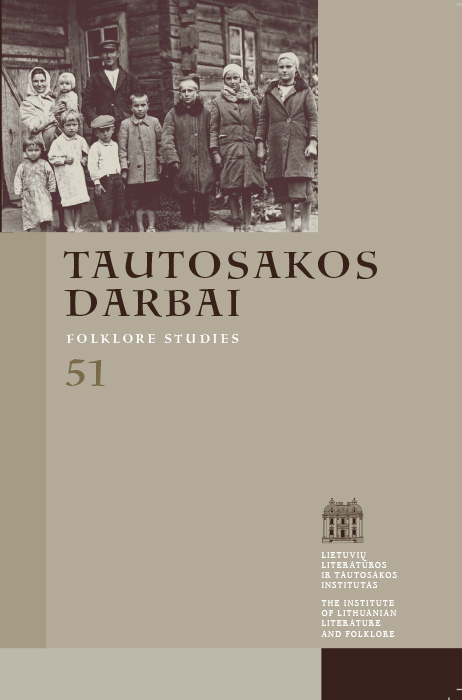Šeimos naratyvas dainose: ritualo atodangos ir kintančių kontekstų reikšmė
Santrauka
Straipsnyje siekiama pasiaiškinti, ar iš dainų, laikomų giluminiais ritualinės kultūros tekstais, būtų galima nubrėžti pagrindinius šeimos naratyvo kontūrus. Iš hermeneutinių prieigų kreipiama interpretacija tikimasi parodyti, kokie šeimos gyvenimo aspektai yra svarbūs dainų poetiniam diskursui ir kokiu pagrindu grindžiamą naratyvą jie leidžia atkurti. Atsižvelgiama į šeimos interpretaciją sunkinančias aplinkybes: ne visada aiškų dainų gyvavimo laiką, dainas veikusią ritualinės atminties, sumišusios su senąja paprotine teise, raidą ir kaitą. Prieinama prie išvados, kad senojo klodo dainos, persmelktos mitinio mąstymo inspiruotos ritualinės pasaulėžvalgos, iš tikrųjų aktualina beveik vieną šeimos gyvenimo temą – kiekvienai šeimai lemiamą reikšmę turėjusį kraujo giminystės praplėtimą naujais giminaičiais, su kuriais per vedybų apeigas susisaistoma kitais – svainystės ryšiais. Būtent skirtumui tarp kraujo ir svainystės giminysčių iš tikrųjų ir skiriamas kone visas konspektyviai apžvelgtas dainų šeimos naratyvas. Šiame straipsnyje platėliau pristatyta kraujo giminystei sureikšminti skirta dainų refleksija.
Atsisiuntimai
Skaitomiausi šio autoriaus(ų) straipsniai
- Bronė Stundžienė, Iš sovietinės dainotyros: tarp pasirinkimo ir prievolės , Tautosakos darbai: T 65 (2023): Tautosakos darbai
- Bronė Stundžienė, Apdainavimų naratyvas ir jo istorinės atminties kontekstai , Tautosakos darbai: T 63 (2022)
- Živilė Ramoškaitė, Bronė Stundžienė, Apžvelgiant dainotyros horizontus. Bronę Stundžienę kalbina Živilė Ramoškaitė , Tautosakos darbai: T 64 (2022)
- Bronė Stundžienė, Kraštovaizdžio raišką dainose apmąstant , Tautosakos darbai: T 47 (2014)
- Bronė Stundžienė, Dainų pašaukti: knyga apie vieno folklorinio ansamblio gyvenimą , Tautosakos darbai: T 57 (2019)
- Bronė Stundžienė, Lietuvių talalinė: šiapus ir anapus leidžiamo juoko ribų , Tautosakos darbai: T 59 (2020)
- Bronė Stundžienė, Laiko žymės Dainyno skelbimo istorijoje , Tautosakos darbai: T 61 (2021)
- Bronė Stundžienė, Įvietinta folklorinė atmintis grožinėje kūryboje: pasvalietiškoji versija , Tautosakos darbai: T 49 (2015)
- Bronė Stundžienė, Atsigręžiant į lietuvių liaudies dainų skelbimo ištakas , Tautosakos darbai: T 56 (2018)
- Bronė Stundžienė, Rita Černiauskienė, Gimnazistiškos vieno etnologinio tyrimo patirtys iš arčiau , Tautosakos darbai: T 57 (2019)
